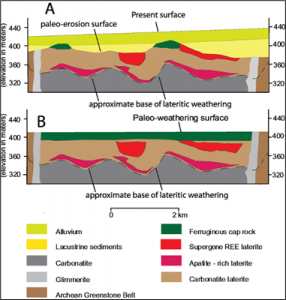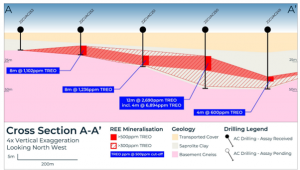What on Earth are Rare Earth Elements REE’s – Part Three
Rare Earth Elements – Part Three
As mentioned in Part One and Part Two, rare earth elements (REE) are all the rage at the moment. Explorers are looking for new projects with rare earth element potential and reassessing existing projects in their portfolios for possible unrealised rare earth element potential. Long-known rare earth element deposits are getting market attention and funding they deserve.
Part Three describes Australia’s premier rare earth element occurrences, the Mount Weld Mine and the Nolans Bore Deposit. I’ll also briefly describe other interesting rare earth element prospects that are attracting attention in Australia.
Mount Weld Mine
Lynas Rare Earths Limited (Lynas) started focusing on rare earth elements at Mount Weld well before rare earth elements rose in exploration status and the hi-tech “battery” end use flame was lit in media coverage.
Using a resource statement contained in a Lynas 2022 presentation, Mount Weld has the following mineral resources/reserves:
- A total Mineral Resource of 55.4Mt at 5.4% TREO (Measured, Indicated and Inferred) for 3,000kT (3Mt) of contained TREO.
- A Measured Ore Reserve of 17.5Mt at 8.0% TREO and 12.0Mt at 12% for 2,060kTt (2Mt) contained TREO.
The resource/reserve total as TREO does not necessarily help in understanding grades of specific rare earth elements. Grade details of specific rare earth elements are gleamed from a Lynas 2017 Annual Report. An in-pit Proved Reserve at Mount Weld of 14.1Mt at 8.8% TREO included 20200ppm (2.2%) Nd2O3+Pr6O11, 300ppm Dy2O3, 21200ppm (21.2%) La2O3 and 41560ppm (4.16%) CeO2.
Healthy grades and the benchmark for the rare earth element hopefuls.
The geology of the Mount Weld deposit is, as might be expected, quite complicated. Essentially, the rare earth elements occur in a supergene layer in the soil profile above a carbonatite. In simple terms, the rare earth elements were concentrated during the weathering of the carbonatite. Through the weathering processing the rare earth elements (as well as uranium, thorium, several types of phosphate, tantalum, vanadium, chromium etc…) were enriched.

Cross section of Mount Weld REE Deposit from M. Cocker 2014 Lateritic, supergene rare earth element (REE) deposits, Arizona Geological Survey Special Paper 9 Chapter 4, 48th Annual Forum on the Geology of Industrial Minerals.
Supergene mineralisation results from the vertical redistribution of metals into a discrete layer. Supergene mineralisation often occurs within a soil profile immediately above the original rock that had contained the metals.
The Mount Weld supergene layer is up to 90m. Below the supergene layer is a residual soil layer that hosts phosphate (apatite) mineralisation.
Remember in Part Two What In Earth Are rare Earth Elements, one of the three main host rocks for rare earth element mineralisation is carbonatite.
The rare earths elements at Mount Weld occur is what is essentially a weathered carbonatite.
Nolans Bore
Arafura’s Nolans Bore rare earth element deposit is debatably a little more complicated than Mount Weld. First things first…. the grade and tonnage..
Using a resource statement (dated 7 June 2017) from Arafura’s website Nolans Bore has the following mineral resources:
- A total Mineral Resource of 56.0Mt at 2.6% TREO (Measured, Indicated and Inferred) with 11% phosphate.
- Of the total rare earth oxide components, 26.4% are Nd2O3 and Pr6O11 (singled out because both Neodymium and Praseodymium are CREO’s (critical are earth oxides – refer to What On Earth are Rare Earths – Part One).
Using a reserves statement (dated 16 March 2016) from Arafura’s website Nolans Bore has the following mineral reserves:
- A total Mineral Reserve of 29.5Mt at 2.9% TREO (Proven and Probable) with 13% phosphate.
- 4% NdPr enrichment (same as the resource figure).
At first glance, Mount Weld and Nolans Bore are remarkably similar in size. The total resources are 55.4Mt and 56Mt respectively. Whereas the TREO grade at Nolans Bore is roughly half that of Mount Weld, Nolans Bore benefits, in a mining sense, of having phosphate (grades >11%).
In broad terms, the Nolans Bore deposit consists of a series of brecciated near-vertical fluorapatite veins that form a complex vein/breccia/stockwork zone affecting a granitic host bedrock. Rare earth elements are associated with these veins, breccias and stockworks.
The veins and bedrock have been highly weathered and it is through this weathering that rare earth elements have become enriched (a secondary enrichment).
Like Mount Weld, rare earth element mineralisation at Nolans Bore is related to the weathering process.
Interestingly, although there is no direct association with a carbonatite at Nolans Bore, as is the case at Mount Weld, at a sub-regional scale, carbonatites, alkaline granites and pegmatites are all present. Detailed studies are indicating that the source of the rare earth elements at Nolans Bore are derived from such carbonatite sources.
A commonality is showing up at Mount Weld and Nolans Bore.
Carbonatite/alkaline granites >>> weathering >>> secondary minerals and mineralisation – rare earth element enrichment >>> associated mineralisation (phosphate) >>> elevated prospectivity >>> potential mining.
These then might start to be considered the “vital signs” for rare earth element exploration (at least within an Australian context).
A good segue onto other rare earth element prospects that are currently making exploration news headlines.
In a Victory Goldfields’ (ASX code: 1VG) announcement with the title Widespread Rare Earth Element System Confirmed (6 September 2022) some of the vital signs are all there: weathered alkaline intrusion mineralised saprolite clays, TREO grades materially above background levels, heathy CREO % levels.
- Best drill hole intersections: 4m at 2,2414ppm TREO (26% NdPr); 8m at 1,876ppm.
- Geology: In situ saprolite clays above deeply weathered bedrock, with proximal alkaline intrusion.
- Mineralisation: Rare earth elements enriched in the weathered profile
In RareX’s Cummings Range deposit announcement with the title Positive Scoping Study For Cummings Range Rare Earth Project (12 September 2022) the familiar vital signs are there again, weathered carbonatite intrusion, mineralised clays, TREO grades materially above background levels, associated phosphate mineralisation, healthy CREO % levels.
- Mineral Resource estimate: 18.8Mt at 1.15% TREO, 9.9% P2O5.
- Geology: A series of steep dipping carbonatite dykes that are highly weathered at surface.
- Mineralisation: Rare earth elements and phosphate enriched in the in situ weathered profile.
Meeka Metals’ (ASX code: MEK) announcement with the title Circle Valley Rare Earth Grades up to 6,894ppm TREO (19 September 2022) is again following the theme: weathered granites, mineralised saprolite clays, TREO grades materially above background levels, heathy CREO % levels.
- Best drill hole intersection: 12m at 2,690ppm TREO (26% NdPr); 8m at 2,766ppm TREO (27% NdPr).
- Geology: In situ clays above deeply weathered granites.
- Mineralisation: Rare earth elements enriched in the weathered profile.

Figure 3 from Meeka’s ASX announcement Circle Valley Rare Earth Grades up to 6,894ppm TREO (19 September 2022).
What is becoming clear from the best rare earth element deposits and the emerging rare earth element deposits are two things:
- Adjacent/proximal source of primary rare earth elements (alkaline intrusions, carbonates).
- Deep in situ weathering that remobilised the rare earth elements into enriched clay/soil/regolith layers.
Rare Earth Element exploration has a real chance in Australia, with huge geological provinces comprising granitic crystalline bedrock, and deep in situ weathering. No doubt rare earth element deposits are “out there” and the junior sector is shuffling across to find them



